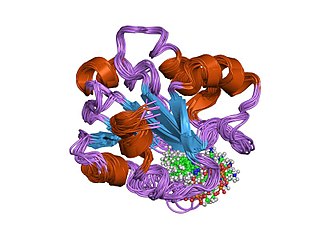Lysine 2,3-aminomutase is a radical SAM enzyme that facilitates the conversion of the amino acid lysine to beta-lysine. It accomplishes this interconversion using three cofactors and a 5'-deoxyadenosyl radical formed in a S-Adenosyl methionine (SAM) activated radical reaction pathway.[1] The generalized reaction is shown below:

In enzymology, a 3-hydroxyacyl-CoA dehydrogenase (EC 1.1.1.35) is an enzyme that catalyzes the chemical reaction
In enzymology, a (3S,4R)-3,4-dihydroxycyclohexa-1,5-diene-1,4-dicarboxylate dehydrogenase (EC 1.3.1.53) is an enzyme that catalyzes the chemical reaction

In enzymology, a cholesterol oxidase (EC 1.1.3.6) is an enzyme that catalyzes the chemical reaction
In enzymology, a 2,4-diaminopentanoate dehydrogenase (EC 1.4.1.12) is an enzyme that catalyzes the chemical reaction
In enzymology, a 2-methyleneglutarate mutase is an enzyme that catalyzes the chemical reaction

In enzymology, D-lysine 5,6-aminomutase is an enzyme that catalyzes the chemical reaction
In enzymology, a D-ornithine 4,5-aminomutase is an enzyme that catalyzes the chemical reaction
In enzymology, a leucine 2,3-aminomutase is an enzyme that catalyzes the chemical reaction
In enzymology, a methylaspartate mutase is an enzyme that catalyzes the chemical reaction
In enzymology, a methylitaconate Δ-isomerase is an enzyme that catalyzes the chemical reaction
In enzymology, a tyrosine 2,3-aminomutase is an enzyme that catalyzes the chemical reaction
The enzyme 3-aminobutyryl-CoA ammonia-lyase (EC 4.3.1.14) catalyzes the chemical reaction
The enzyme ethanolamine ammonia-lyase (EC 4.3.1.7) catalyzes the chemical reaction
In enzymology, a N6-acetyl-beta-lysine transaminase is an enzyme that catalyzes the chemical reaction

In enzymology, a nicotinate-nucleotide-dimethylbenzimidazole phosphoribosyltransferase is an enzyme that catalyzes the chemical reaction

In molecular biology, the vitamin B12-binding domain is a protein domain which binds to cobalamin. It can bind two different forms of the cobalamin cofactor, with cobalt bonded either to a methyl group (methylcobalamin) or to 5'-deoxyadenosine (adenosylcobalamin). Cobalamin-binding domains are mainly found in two families of enzymes present in animals and prokaryotes, which perform distinct kinds of reactions at the cobalt-carbon bond. Enzymes that require methylcobalamin carry out methyl transfer reactions. Enzymes that require adenosylcobalamin catalyse reactions in which the first step is the cleavage of adenosylcobalamin to form cob(II)alamin and the 5'-deoxyadenosyl radical, and thus act as radical generators. In both types of enzymes the B12-binding domain uses a histidine to bind the cobalt atom of cobalamin cofactors. This histidine is embedded in a DXHXXG sequence, the most conserved primary sequence motif of the domain. Proteins containing the cobalamin-binding domain include:
Acetoanaerobium sticklandii is an anaerobic, motile, gram-positive bacterium. It was first isolated in 1954 from the black mud of the San Francisco Bay Area by T.C. Stadtman, who also named the species. A. sticklandii is not pathogenic in humans.
Glutamate 2,3-aminomutase is an enzyme that belongs to the radical s-adenosyl methionine (SAM) superfamily. Radical SAM enzymes facilitate the reductive cleavage of S-adenosylmethionine (SAM) through the use of radical chemistry and an iron-sulfur cluster. This enzyme family is implicated in the biosynthesis of DNA precursors, vitamin, cofactor, antibiotic and herbicides and in biodegradation pathways. In particular, glutamate 2,3 aminomutase is involved in the conversion of L-alpha-glutamate to L-beta-glutamate in Clostridium difficile. The generalized reaction is shown below:





